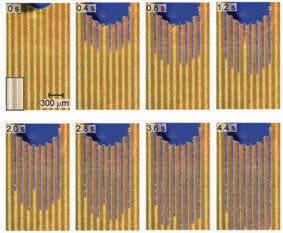May 24, 2010
|
Time-lapse images demonstrate the directional formation of straight channels on a lab-on-a-chip device |
Microfluidics has been around for nearly three decades, offering scientists a platform for developing a range of medical applications, from clinical diagnostic and lab-on-a-chip products to drug-delivery and implantable devices. Although it has been studied intensely, microfluidics technology has been constrained by its inability to create definable and manipulable microchannel structures capable of performing diverse functions. But now, Jason Heikenfeld and Ian Papautsky, associate professors of electrical engineering at the University of Cincinnati (UC), are collaborating on a method for creating movable microfluidic channels that could greatly expand the technology's flexibility.
"Today's microfluidic lab-on-a-chip devices are often fabricated from a polymer--especially for medical applications where we often want cheap, disposable devices," remarks Papautsky, director of UC's BioMicroSystems Lab and the Micro/Nano Fabrication Engineering Research Center. "These devices contain a fixed arrangement of microchannels." Each lab-on-a-chip must be designed to serve a specific function, typically a single assay. "In essence, today's lab-on-a-chip devices are really instruments-on-chip," Papautsky adds. "By offering a possibility of creating custom microfluidic channel networks, our technology brings us closer to the concept of a lab-on-a-chip with its ability to perform multiple assays on a single device."
Capable of delivering high throughputs, conventional microfluidic devices are designed predominantly for continuous flows--for example, fluid flows propelled by syringe pumps, Papautsky explains. In contrast, a subset of microfluidics known as digital microfluidics manipulates discrete droplets using electric fields. The advantage of this approach is that droplets can be moved, combined, or separated over the 2-D area of the planar electrodes. In such devices, the manipulation of one or more droplets can be achieved by programming the order and location of the applied potential--a phenomenon that Papautsky likens to moving pieces on top of a chessboard. "Our technology combines these two domains," he says. "We use electric fields to create virtual microfluidic channels--virtual because they are not confined within physical walls. Then, we expect to be able to continuously move liquids through the established conduits."
The UC researchers' chip contains an array of polymer posts that are coated with a metal conducting electrode and a hydrophobic dielectric insulator material. When a potential is applied to the array, local changes in the wetting contact angle cause liquid to flow between the posts, forming virtual channels that can be manipulated to perform different types of assays.
Given this capability, the scientists' microfluidic chip could find its way into such medical applications as point-of-care diagnostic devices. "Essentially, our technology will permit multiple or sequential diagnostic assays to be performed using the same device. This would be of particular importance for resource-limited environments such as Third World countries," Papautsky says.
Heikenfeld and Papautsky are working with Philip Rack, an associate professor in the department of materials science and engineering at the University of Tennessee (Knoxville), on integrating their microfluidic chip with the same electronics that drive the pixels in an LCD display. As a result, the technology could be integrated into portable, handheld instruments. "Ultimately disposable, the microfluidic chip could be the size of a memory card or matchbook, and the handheld instrument or reader could be the size of an iPhone," Heikenfeld notes. "The chip could be inserted into the reader, and the reader software would permit the user to define assays or channel configurations, somewhat analogous to a glucose monitor."
You May Also Like



